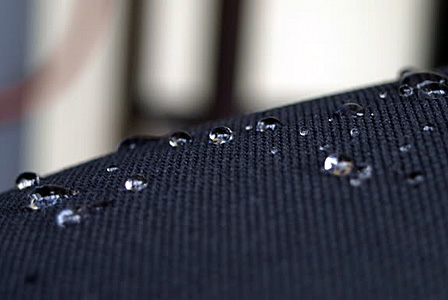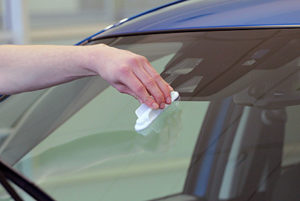Nano protection for textile and leather
 Nano protection for car interior is a single component substance for protecting textile and leather parts, forming an invisible film on every textile fibre.
Nano protection for car interior is a single component substance for protecting textile and leather parts, forming an invisible film on every textile fibre.
This coating prevents adherence of dirt and ensures long-term protection against moisture. Droplets of such liquids as coffee, juice or wine do not absorb in the material but roll off the surface.
Surfaces that are covered with nano coating are easy to clean and they are resistant to chemical cleaning. Nano coating does not affect the fabric’s appearance, its roughness or its ability to breathe.
Before applying hydrophobic protection of the nano coating, the textile or leather shall be thoroughly cleaned. In case nano coating will be applied on a dirty surface, it will be very difficult to clean this surface later on. Before treating the textile surfaces with nano coating we recommend chemical cleaning of the textile and / or cleaning of the leather seats.
Important to know: nano coatings foreseen to be applied on textile or leather do not emit allergic fumes after drying and they are all absolutely harmless.
| 1. faas Vahetult pealekandmise järel. |  |
| 2. faas Lühikese aja jooksul algab osakeste paigutumisprotsess. |  |
| 3. faas Tahkunud olek. |  |
Nagu kõik moodsad tehnoloogiad, on ka autokeemia hakanud põhinema nanotehnoloogial, ja selliste ainetega auto töötlemine annab päris imepäraseid tulemusi.
Nanotehnoloogial põhinevate ainetega auto töötlemisega tegeleva SmartService'i sõnul on kerele ja klaasidele kantaval vahal kolm kihti.
Esimene on see, mis seob ülejäänud kihid autoga, teine on põhikiht ja kolmas on libekiht. Viimane neist paneb vee ja mustuse auto pealt ära jooksma. Autol tekib sellise ainega katmisel isepuhastuv efekt.
Mõte on selles, et kui vihma sajab ja piisad kukuvad autole, siis sõites veab kiht tuulega vihmavee koos mustusega autolt minema. Tõsi, see pole päris sama mis pesemine, kuid auto seisab märksa kauem puhtana kui muidu.
Samuti on sellisel vahal kaitsefunktsioon, mis ei lase mustusel sügavale värvkattesse tungida, see tähendab, et autoga pesulasse minnes pole vaja mitmeid leotusi läbida, enne kui auto puhtaks saab.
Sama ainet kantakse ka aknaklaasidele, mis kindlustab selle, et vihma korral jookseb vesi ise tuulega minema. Enamjaolt pole kojamehi üldse vajagi. Näiteks maanteel suurema kiirusega sõites võib ka paduvihmaga kojameeste kangi peaaegu puutumata jätta.
 Benefits of nano coating:
Benefits of nano coating:
- transparent and long term protection;
- easy application;
- odourless;
- short drying time;
- does not require additional energy;
- high efficiency thanks to economic consumption;
- does not contain solvents;
- does not become mossy and does not activate fungus;
- high-pressure water-jet resistant;
- ttreated surfaces are easy to clean;
- extremely friction resistant.
Frequently Asked Questions of nano products:
How long does hydrophobic effect of nano coating last?
he resistance of nano coating on a treated car body lasts for 9-12 months, depending on the mileage and the frequency the car is washed.
A windshield of the car treated with the product “Anti-rain” will preserve its properties 15,000–20,000 km, side glasses 60,000 km.
On alloy wheels the properties will last for a year. Of course operation conditions have a great impact here.
What is the thickness of nano coating after it is applied on the surface?
1 nanometre (nm) is one billionth or 10-9 metres, which means that the thickness of the layer is 20-60 nm.
What is the difference between nano coating and car waxing?
The main difference is the resistance of one or another coating. Liquid wax will last 1-3 months, carnauba-based solid wax will last approximately 6 months and nano coating up to one year. Chemical industry is in constant development and already now totally new coatings are available on the market that last up to 5 years. The rule is that the cheaper is the wax the shorter it will last. All given resistance times are approximate and depend greatly on the operation conditions of the car and mileage. For instance in case the annual mileage of the car is 600,000 km in road conditions, all resistance times should be decreased to half.
You did not find an answer you were looking for? Send us your question in writing and we will for sure answer to you and post your question with the answer here.
...

